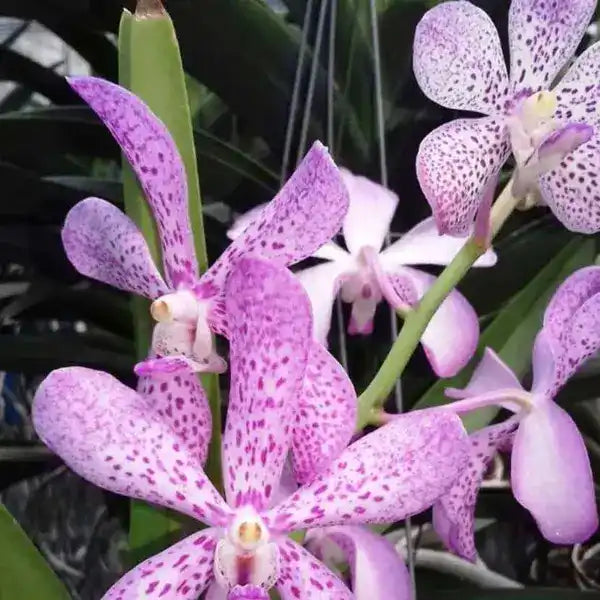
Mokara (MM-046)
Selling Size : Last Image | Secure Packing
Mokara orchids are beautiful hybrids known for their vibrant blooms and relative ease of care, making them a great choice for both beginners and experienced orchid enthusiasts.
Here's a comprehensive guide to Mokara care:
Light
Mokara orchids thrive in bright, indirect sunlight. This mimics their natural tropical environment.
Indoors:
East-facing windows are ideal for gentle morning sun.
South-facing windows work well if you use sheer curtains to diffuse direct rays.
Avoid harsh afternoon sun from west-facing windows as this can lead to leaf burn.
Outdoors: In warm, humid climates, they do best in partial shade, protected from intense afternoon sun.
Tip: If natural light is limited, LED grow lights can supplement their needs. Aim for a light intensity of 25,000 to 35,000 lux for optimal growth and flowering. Yellowish-green or reddish foliage can indicate too much light.
Temperature
Mokara orchids prefer warm, stable temperatures.
Daytime: Ideally between 70-90°F (21-32°C).
Nighttime: Should not drop below 60°F (15°C).
Temperature drop: A 10-15°F (5-8°C) temperature drop between day and night can help encourage blooming.
Avoid cold drafts or placing them near heating/cooling vents.
Watering
Consistent watering is crucial, but avoid overwatering.
Frequency: Water once a week or when the potting medium feels dry to the touch. In hotter months or drier climates, they may need more frequent watering (2-3 times a week, or even daily in very hot conditions).
Method: Water thoroughly until water drains from the bottom of the pot. Ensure no water is left standing in the pot's bottom or tray, as this can lead to root rot.
Best time: Water in the morning so the plant has time to dry before cooler nighttime temperatures.
Root system: If your orchid has a small or damaged root system, you might need to soak the roots daily for longer periods (e.g., 15 minutes to an hour) until new roots develop.
Humidity
Mokara orchids prefer high humidity levels, ideally between 50-80%.
To increase humidity:
Use a humidity tray (a tray with pebbles and water, ensuring the pot doesn't sit directly in the water).
Mist the plant regularly, especially in drier environments, but avoid getting water between the leaves, especially if indoor air circulation is poor, to prevent rot.
Place them in naturally humid areas like a well-lit bathroom.
Air Circulation: Good air circulation is essential to prevent fungal diseases, especially with high humidity. Ensure the plant is in a well-ventilated space, but avoid direct drafts. A small fan on a low setting can be beneficial.
Fertilizing
Mokara orchids are relatively heavy feeders, especially during their active growing season.
Type: Use a balanced orchid fertilizer.
Frequency: Fertilize every 2-4 weeks during the active growing season (typically spring to fall).
Dilution: Many growers recommend diluting the fertilizer to 50% of the recommended strength to prevent salt buildup, which can burn roots. However, some very fast-growing Mokara species might benefit from a stronger solution (even 200% of recommended strength).
Winter: Cut back on fertilization during the winter dormancy period (if your specific Mokara species has one).
Flush: Regularly flush the pot with plain water to prevent soluble salts from building up in the potting medium.
Potting Medium and Repotting
Mokara orchids typically do well in a well-draining medium.
Medium: Large bark chunks, coconut husk (coco peat), charcoal, lava rock, or even broken bricks are good choices. The key is good drainage to prevent "wet feet." Some specific Mokara species can even do well in regular potting soil.
Pot: Choose a pot with good drainage. Some growers prefer pots with a wide surface area for roots to emerge.
Repotting:
Fast-growing species might need repotting once or even several times a year.
Slower-growing Mokaras are best repotted every 2-3 years.
The best time to repot is usually after the flowering season. However, since some Mokara orchids bloom continuously, you might need to repot them while they are flowering.
Common Problems and Solutions
Drooping/Wrinkled Leaves: Often a sign of watering problems (either too much leading to root rot, or too little). Check roots; mushy brown roots indicate overwatering, shriveled grey roots indicate underwatering. Address the watering schedule and consider repotting with fresh medium if roots are severely damaged.
Root Rot: Caused by overwatering and poor drainage. Roots become soft and mushy. Ensure proper watering and a well-draining medium.
Leaf Scorch/Yellowing: Direct, intense sunlight can burn leaves, causing scorched blotches or overall yellowing. Move to a location with bright, indirect light.
Bud Blast: Flower buds shrivel and fall off before opening. This is often due to sudden environmental changes (temperature fluctuations, low humidity), or issues with watering or nutrients. Avoid moving the plant once buds begin to form.
Pests: Common orchid pests include scale, aphids, mites, and thrips. Inspect your plant regularly and treat with appropriate insecticides or horticultural oils if needed.
Fungal Issues: Problems like black rot or Botrytis can occur in cool, damp conditions with poor airflow. Ensure good ventilation and avoid prolonged wetness on leaves.
By providing the right balance of light, temperature, humidity, water, and nutrients, you can enjoy the stunning and long-lasting blooms of your Mokara orchid throughout the year.

